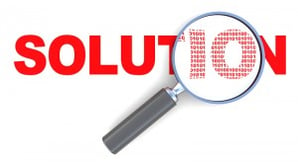Four Clues to Evaluating Current Manufacturing Software
If you take the pulse of the manufacturing software market, you’ll be surprised by what you discover. We recently did an early demo of our product...
5 min read
David Oeters : March 6, 2014 at 9:50 AM
 Selecting an MES (Manufacturing Execution System) or Paperless Manufacturing system is a critical task for manufacturer. If successful, the system will positively transform manufacturing by improving production and quality, managing and collecting information on the production process, eliminating errors, and ensuring real-time shop floor control and visibility among other benefits. The system could deliver an ROI in months, and continue to save money and improve profits for years to come.
Selecting an MES (Manufacturing Execution System) or Paperless Manufacturing system is a critical task for manufacturer. If successful, the system will positively transform manufacturing by improving production and quality, managing and collecting information on the production process, eliminating errors, and ensuring real-time shop floor control and visibility among other benefits. The system could deliver an ROI in months, and continue to save money and improve profits for years to come.
This sounds nice, but there is risk involved in selecting and implementing a shop floor solution. The project requires an investment of time, energy, focus and resources, especially for IT (Information Technology) professionals tasked with upkeep on the system.
Never fear, here we offer six common sense and easy-to-use tips for IT professionals to help ensure your MES and paperless manufacturing selection project is a success.
Unfortunately, many vendors will offer a lower initial cost for the software and licenses, fully expecting to make profit on service charges or necessary hardware installation. They know once an installation begins, it becomes increasingly difficult and costly to remove and replace it. Vendors know IT won’t be able to self-support their solution, so they can charge what they want to ensure the solution works as promised.
 Look for MES and paperless manufacturing systems that use non-proprietary hardware and software. Study the hardware, and make sure you can self-support the solution if you need to. The shop floor can be chaotic, and hard on hardware. Make sure you can easily purchase and replace hardware that fails. For example, hard drives are one of the most failure prone components in a computer. To address these reliability issues many modern servers offer features like hot-swappable RAID hard drive arrays. These arrays provide fault tolerance through redundant drives, and replacing a failed drive is as simple as sliding the bad drive out and sliding in a new one. Make sure the software isn’t custom-built, or so “configurable” the upgrade options are limited. Custom software will drastically increase the Total Cost of Ownership (TCO) of the solution. Software that isn’t flexible or adaptable will soon become a legacy system holding back your IT department and shop floor. Look for systems that allow “custom applications” without high costs, and won’t compromise the ability to upgrade the system to meet future needs.
Look for MES and paperless manufacturing systems that use non-proprietary hardware and software. Study the hardware, and make sure you can self-support the solution if you need to. The shop floor can be chaotic, and hard on hardware. Make sure you can easily purchase and replace hardware that fails. For example, hard drives are one of the most failure prone components in a computer. To address these reliability issues many modern servers offer features like hot-swappable RAID hard drive arrays. These arrays provide fault tolerance through redundant drives, and replacing a failed drive is as simple as sliding the bad drive out and sliding in a new one. Make sure the software isn’t custom-built, or so “configurable” the upgrade options are limited. Custom software will drastically increase the Total Cost of Ownership (TCO) of the solution. Software that isn’t flexible or adaptable will soon become a legacy system holding back your IT department and shop floor. Look for systems that allow “custom applications” without high costs, and won’t compromise the ability to upgrade the system to meet future needs.
Too often, integration with existing enterprise systems is phase 2 of a project, leading to unwelcome surprises and significant service charge expenses. Achieving full integration may require shop floor disruption or unexpected process changes, leading to additional costs or unfinished projects.
Avoid problems by asking for a design schema of an integration plan before you implement the project. Map out phase 2 of the project early and determine a reliable cost estimate for the work. This will help ensure you have a realistic ROI for the project and will keep the vendor honest. Looking at the integration plan will also help identify potential problems before they become full-scale disasters. There are many ways to integrate two or more systems – they vary from easy and low cost to complex and high cost.
In software projects the cost to fix a problem increases exponentially the longer it goes undiscovered, so finding issues early is crucial. Particularly with integration projects communication failure is often the root cause of many problems. While thorough planning can help, reviewing plans with the other teams involved can often open the lines of communication and bring potential issues to light much sooner.
 Beware of solutions that require significant time to install, configure or build. “Building” a solution, or time spent configuring the software, is another way to describe customization.
Beware of solutions that require significant time to install, configure or build. “Building” a solution, or time spent configuring the software, is another way to describe customization.
In addition, the final solution you receive may not work as intended. Many times a vendor will offer a “demo” presentation of the software, but once the code is written, the final product is very different.
This is especially true of software that uses “modules.” Often, these modules are built by different companies (which the vendor purchases) and are then integrated on your shop floor. Each individual module may work well, but when crammed together the entire package loses effectiveness. Pieces don’t work well together, which leads to problems upgrading the software.
One often overlooked but critical part of any new upgrade or installation is thorough and accurate testing. To get the most value out of the time and resources which you have invested in the testing process be sure you are testing with realistic data and that your tests accurately reflect how users interact with your system.
Look for a simple and effective configuration and installation plan that keeps the focus on your operation, not the needs of the software vendor. For example, software that can easily be installed in phases will ensure you are in control of the installation, and the focus will be on the shop floor solutions that deliver the greatest ROI, not the convenience of the vendor. Beware of vendors that leave you with a one-of-a-kind solution with little documentation and expensive follow on support.
“Implementation” is a loaded word in the world of information technology, paperless manufacturing and MES.
 For the IT department, implementation may mean integration with existing software systems. It means installing the software and making sure the hardware is in place and working. It’s eliminating “bugs” before you turn on the system. It’s the behind-the-scenes work that can be done after hours or on test data bases before the go-live date.
For the IT department, implementation may mean integration with existing software systems. It means installing the software and making sure the hardware is in place and working. It’s eliminating “bugs” before you turn on the system. It’s the behind-the-scenes work that can be done after hours or on test data bases before the go-live date.
But implementation may mean something completely different for the shop floor, and the difference is critical. When selecting new software, look at how it works with existing shop floor processes. Does it use existing plans? Is there a plan in place to digitize or upload existing work instructions for shop floor use? Or does the software use templates that require changes in the work plans or processes? How easy is the software to use? Does it have revision control or procedural enforcement?
While the software and hardware are important, if the shop floor can’t or won’t use the software, you’ll never achieve an ROI. Make sure you have input from the shop floor users before you make a purchase, and look at how (potentially) disruptive the software will be to existing processes and shop floor operations.
 Many times, the goal of a paperless manufacturing project is to replace an inefficient legacy software system on the shop floor. Yet, as the new system is installed, steps aren’t taken to ensure it won’t become legacy software.
Many times, the goal of a paperless manufacturing project is to replace an inefficient legacy software system on the shop floor. Yet, as the new system is installed, steps aren’t taken to ensure it won’t become legacy software.
Make sure the software vendor offers an upgrade plan to capitalize on new technology and avoid software obsolescence. Ask the vendor for an estimate (or guaranteed) price for an upgrade. Go over the steps for an upgrade and look at how disruptive the project will be to operations and the shop floor.
The one constant in manufacturing is change – Engineering Change Orders (ECO’s), regulation change, infrastructure change, custom manufacturing, new technology, new tools, new workers, and more. Your shop floor software system needs to accommodate change through upgrade or configuration since process change requires software changes to be fully effective. Take a moment to evaluate the cost in time and resources of change before installation.
Finally, take a moment to evaluate the vendor and the support plan (or customer service plan) for the software. Are you comfortable with the level of support and the vendor as a partner?
Many vendors initially offer a team of support personnel and an entire menu of possible service charges and tiers of support, but the truth is you want software that works as promised, and a partner who understands your shop floor and software when you need it. Trust is important, even in paperless manufacturing and MES. If you need help, is there a phone number and email you can use to reach a person you trust? You’ll be working closely with the vendor throughout the life of the software. Make sure to select a vendor who will work with you, and won’t leave you at the tender mercy of a service line.
******
There is no magic checklist we can offer to guarantee a successful paperless manufacturing installation, but we’ve seen the success other companies have had in selecting, implementing and using paperless manufacturing, and the tips we’ve collected here will give IT professionals in manufacturing an edge as they begin their own project.
Want to learn more or speak with one of our experts, visit our website at www.cimx.com or give us a call. We’re happy to help.

If you take the pulse of the manufacturing software market, you’ll be surprised by what you discover. We recently did an early demo of our product...
1 min read
You have more hardware options than ever before for your paperless manufacturing software, and it’s critical you select the right solution. CIMx...

Paperless Manufacturing Systems can Quickly and Easily Deliver Even More Benefits Than You May Think By David Oeters, Corporate Communications with...